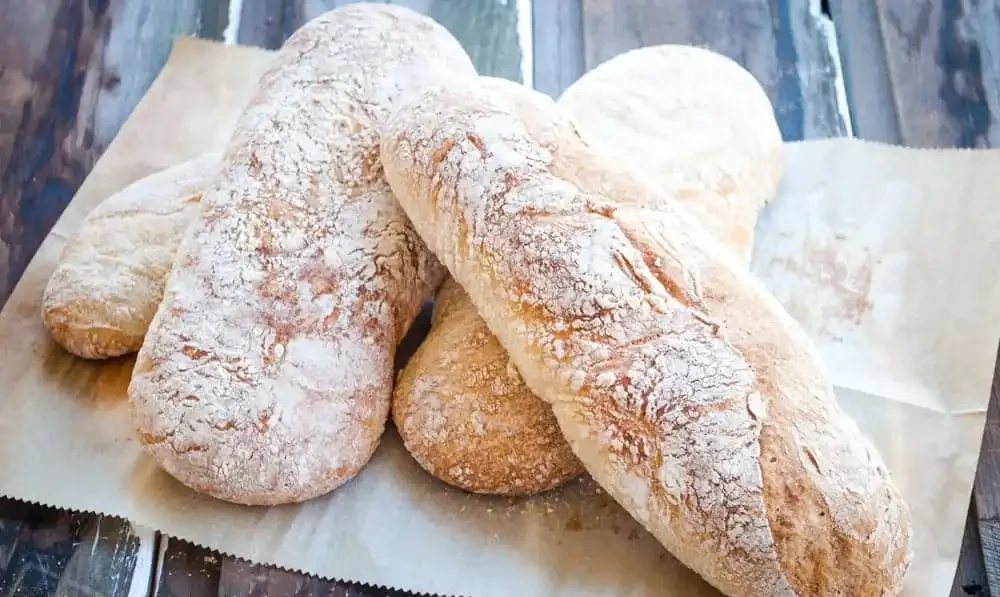
The Differences Between a Sourdough Bread and Ciabatta Bread
When it comes to bread, there are countless varieties to choose from, each with its own unique characteristics and flavors. Two popular types of bread that often make it to the top of the list are sourdough bread and ciabatta bread. While both are delicious options, they have distinct differences that set them apart.
In this article, we will explore the differences between a sourdough bread and ciabatta bread, diving into their ingredients, baking techniques, textures, and flavors. So let’s get started and uncover the secrets behind these two mouthwatering breads!
Table of Contents
ToggleWhat is Sourdough Bread?
Sourdough bread is a type of bread that is made using naturally occurring yeast and bacteria, creating a unique and tangy flavor profile. It has a long history and is known for its characteristic open crumb structure and chewy texture. The fermentation process of sourdough bread involves a starter, which is a mixture of flour and water left to ferment over a period of time, allowing the natural yeast and bacteria to develop.

What is Ciabatta Bread?
Ciabatta bread, hailing from Italy, is famous for its light and airy composition. Its distinctive texture is achieved through the use of a high-hydration dough, resulting in a chewy inside and a crust that’s delightfully crispy. This elongated bread, aptly named “ciabatta,” meaning “slipper” in Italian, owes its moniker to its flat and slipper-like appearance. Its unique characteristics make it a beloved choice for sandwiches, bruschetta, and various delectable dishes.
Ingredients
Sourdough bread is made using simple ingredients such as flour, water, salt, and a sourdough starter. The starter consists of flour and water that has undergone fermentation, which gives the bread its distinct tangy taste.
Ciabatta bread, on the other hand, typically includes flour, water, yeast, salt, and sometimes olive oil. The addition of olive oil contributes to the bread’s softness and distinct flavor.
Fermentation Process
The fermentation process for sourdough bread involves the use of a sourdough starter, which contains wild yeast and lactobacilli bacteria. This starter is added to the dough mixture and left to ferment for an extended period, ranging from several hours to several days. The long fermentation time allows for the development of complex flavors and textures.
Ciabatta bread, on the contrary, undergoes a shorter fermentation process. It uses commercial yeast, which acts as a leavening agent, causing the dough to rise faster. This shorter fermentation time results in a bread with a milder flavor compared to sourdough.
Texture and Crust
Sourdough bread is characterized by its chewy texture and irregular crumb structure. The long fermentation process and the presence of wild yeast create air pockets in the dough, leading to an open and holey interior. The crust of sourdough bread is typically thick and crispy.
In contrast, ciabatta bread has a light and airy texture. Its high hydration level contributes to its soft and moist crumb. The crust of ciabatta bread is thin and crispy, providing a delightful contrast to its soft interior.
Flavor Profile
Sourdough bread boasts a distinct tangy flavor, thanks to the lactic acid produced during fermentation. This unique taste, combined with the nutty and slightly sweet undertones of the wheat, creates a flavor that is loved by many bread connoisseurs.
Ciabatta bread has a more subtle flavor profile. Its taste is mild, with hints of wheat and yeast. The addition of olive oil can lend a subtle fruity note to the bread’s flavor.
Versatility in Recipes
Sourdough bread’s robust flavor and chewy texture make it a versatile choice for various recipes. It is perfect for sandwiches, toast, and even as a base for gourmet bruschetta. Its tangy taste can complement both savory and sweet toppings.
Ciabatta bread’s light and airy texture make it an excellent choice for sandwiches, particularly those with hearty fillings. It can also be sliced and served alongside soups and stews, as it absorbs flavors well without becoming overly soggy.
Nutritional Value
Both sourdough bread and ciabatta bread offer nutritional benefits. They are good sources of carbohydrates, providing energy for the body. Sourdough bread, due to its fermentation process, may be easier to digest for some individuals. It can also have a lower glycemic index compared to other bread types.
Ciabatta bread contains essential nutrients such as iron, selenium, and B vitamins. However, it is important to note that the nutritional content can vary based on the specific recipe and ingredients used.
Storage and Shelf Life
Sourdough bread has a longer shelf life compared to many other bread types. Its natural acidity helps to preserve the bread, allowing it to stay fresh for several days. It is best stored in a paper bag or a bread box to maintain its crust texture.
Ciabatta bread is best enjoyed fresh on the day it is baked. However, if you have leftovers, it can be stored in an airtight container or wrapped in plastic wrap for up to two days. Reheating the bread in an oven or toaster can help revive its texture.
Baking Techniques
Sourdough bread requires a more complex baking process due to its reliance on natural yeast and bacteria. It involves several stages, including the preparation of the sourdough starter, bulk fermentation, shaping, and proofing. Baking sourdough bread often requires a preheated oven and steam to achieve the desired crust.
Ciabatta bread is relatively simpler to bake. The dough is mixed, fermented for a shorter period, shaped into an elongated form, and then baked in a hot oven. Steam can also be used to create a crispy crust.
Cultural Significance
Sourdough bread holds cultural significance in many regions around the world. It has a rich history and is deeply rooted in traditions, particularly in San Francisco, where sourdough has become an iconic symbol of the city’s culinary heritage.
Ciabatta bread, originating from Italy, is a staple in Italian cuisine. It has gained popularity worldwide and is widely associated with Italian sandwiches, such as panini.
Popularity
Both sourdough bread and ciabatta bread have gained popularity among bread enthusiasts and in the culinary world. The unique flavors, textures, and versatility of these bread types have contributed to their widespread appeal.
Serving and Pairing Suggestions
Sourdough bread can be served in various ways. It pairs well with creamy cheeses, cured meats, and spreads like avocado or hummus. It is also excellent when used for dipping in olive oil and balsamic vinegar.
Ciabatta bread is ideal for making sandwiches, such as classic Italian subs or grilled panini. It can also be sliced and served alongside antipasto platters, soups, or used as a base for bruschetta toppings.
Which One is Better: Sourdough Bread or Ciabatta Bread?
When it comes to determining which bread is better between sourdough bread and ciabatta bread, it ultimately boils down to personal preference and the intended use. Both bread types have their unique characteristics and flavors that make them stand out. Let’s take a closer look at the qualities of each bread to help you decide which one might be better for you.
Sourdough Bread:
Sourdough bread offers a distinct tangy flavor that is loved by many bread enthusiasts. The long fermentation process using a sourdough starter contributes to its complex taste. The chewy texture and irregular crumb structure of sourdough bread add to its appeal. This bread is versatile and can be used in various recipes, ranging from sandwiches to gourmet bruschetta. Additionally, sourdough bread often has a longer shelf life compared to other bread types, making it convenient for those who like to have bread on hand for several days.
Ciabatta Bread:
Ciabatta bread, on the other hand, boasts a light and airy texture. It is known for its elongated shape and crispy crust. The high-hydration dough used in making ciabatta results in a soft and moist crumb. This bread is particularly popular for making sandwiches, as it holds up well to hearty fillings without becoming overly dense. Its mild flavor allows the other ingredients in a sandwich to shine. However, ciabatta bread is best enjoyed fresh on the day it is baked due to its shorter shelf life.
Choosing the Better Bread:
Choosing between sourdough bread and ciabatta bread depends on your taste preferences and how you plan to use the bread. If you enjoy a tangy flavor and chewy texture, and you appreciate the versatility of a bread that can be used in various recipes, then sourdough bread may be the better choice for you. On the other hand, if you prefer a bread with a light and airy texture, especially for making sandwiches, then ciabatta bread might be the better option.
In the end, the “better” bread is subjective and depends on your personal preferences and the specific purpose for which you plan to use the bread. Experimenting with both types of bread can help you discover which one aligns more with your taste and culinary preferences.
Frequently Asked Questions About Differences Between a Sourdough Bread and Ciabatta Bread
Can sourdough bread and ciabatta bread be frozen for later use?
Are sourdough bread and ciabatta bread suitable for individuals with gluten sensitivity?
Can I make sourdough ciabatta bread by combining the characteristics of both bread types?
Which bread is better for making toast?
Conclusion
In conclusion, while both sourdough bread and ciabatta bread are beloved artisan bread types, they have distinct differences. Sourdough bread offers a tangy flavor, chewy texture, and a longer fermentation process using a sourdough starter. Ciabatta bread, on the other hand, has a light and airy texture, a milder flavor, and a shorter fermentation process. Each bread has its unique qualities that make them a delightful choice for various culinary creations.
Lindsey Mackenzie
About me
Hi there! I’m Lindsey Mackenzie, the founder of Bake Smartly. Baking has been my passion since childhood, growing up in my father’s bakery. With Bake Smartly, I’m excited to share my love for all things sweet and savory. Join me on this delicious journey as we whip up scrumptious treats and sprinkle joy into every bite!






